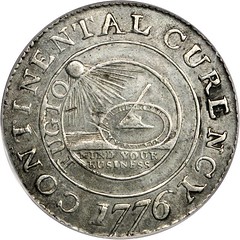
About UsThe Numismatic Bibliomania Society is a non-profit organization promoting numismatic literature. For more information please see our web site at coinbooks.org SubscriptionsThose wishing to become new E-Sylum subscribers (or wishing to Unsubscribe) can go to the following web page link MembershipThere is a membership application available on the web site Membership Application To join, print the application and return it with your check to the address printed on the application. Membership is only $15 to addresses in the U.S., $20 for First Class mail, and $25 elsewhere. For those without web access, write to: David M. Sundman, Secretary/TreasurerNumismatic Bibliomania
Society AsylumFor Asylum mailing address changes and other membership questions, contact David at this email address: dsundman@LittletonCoin.com SubmissionsTo submit items for publication in The E-Sylum, just Reply to this message, or write to the Editor at this address: whomren@coinlibrary.com
BUY THE BOOK BEFORE THE COINYou won't regret it! |
- WAYNE'S WORDS: THE E-SYLUM NOVEMBER 18, 2012
- THE ASYLUM JULY-SEPTEMBER 2012 ISSUE HAS BEEN PUBLISHED
- NBS WEB SITE BIBLIOGRAPHY IMPROVEMENTS
- SMITH'S AMERICAN NUMISMATIC BIOGRAPHIES UPDATED
- KOLBE & FANNING HOLD WEEK-LONG “BLACK FRIDAY” SALE
- NEW BOOK: NOTTINGHAMSHIRE VICTORIA CROSS HEROES
- RUSSELL RULAU 1926-2012
- RULAU'S AMERICAN TOKEN FINDER COLUMNS SOUGHT
- THE SOUTHERN CALIFORNIA ORDERS & MEDALS SOCIETY
- MORE ON CONTEMPORARY COUNTERFEITS
- GRIMASON'S THEORY ON THE 1776 CONTINENTAL CURRENCY COINAGE
- NOTES FROM E-SYLUM READERS: NOVEMBER 18, 2012
- QUERY: REVIEWS OF BOOKS ON MINT AND COINS OF UKRAINE SOUGHT
- QUERY: EVER HEARD OF THE 7 1/2 CENT "COCA COLA" COIN?
- REJECTED COIN DESIGNS
- WASHINGTON POST ARTICLE ON LOCAL CURRENCY
- 2013 PARIS AND MADRID ROUNDTABLES ON SMALL CHANGE
- DAVE ALEXANDER'S SUPERSTORM SANDY DIARY
- WAYNE'S NUMISMATIC DIARY: NOVEMBER 18, 2012
- QUERY: WILL 'SHIP OF GOLD' BECOME A FILM?
- HOLABIRD-KAGIN AMERICANA DECEMBER 2012 AUCTION
- BALDWIN'S 2013 NEW YORK SALE
- NUMISMATIK LANZ AUCTION 155, DECEMBER 2012
- DRAWER FIND: 1703 QUEEN ANNE VIGO FIVE GUINEA PIECE
- EXPERTS DEBATE AUTHENTICITY OF COIN OF EMPEROR PROCULUS
- SRI LANKAN-JAPAN COMMEMORATIVE COIN AVAILABLE ONLY IN JAPAN
- MORE COIN-ONLY PARKING METERS DISAPPEAR
- ON SPENDING DIRTY OLD BANKNOTES
- THE WORLD'S LARGEST CHINESE CASH COIN
- THE BIBLIO-MAT OLD BOOK VENDING MACHINE
- FEATURED WEB PAGE: THE MYTH OF "VIGO"
WAYNE'S WORDS: THE E-SYLUM NOVEMBER 18, 2012

New subscribers this week include Ray Benzal. Welcome aboard! We have 1,605 email subscribers, plus 199 followers on Facebook.
This week we open with word on the latest issue of The Asylum, updates on the NBS web site, and an announcement of a numismatic literature sale. Next up is a new booklet on Victoria Cross heroes and remembrances following the passing of numismatic author Russ Rulau.
Other topics include contemporary counterfeits, alternative currencies, and coin auctions galore. To learn more about exonumia, the Southern California Orders & Medals Society, V-2 Rocket testing, the 7 1/2 cent coin, poet William Butler Yeats' coin committee, the VIGO coinage, and the World's Largest Chinese Cash Coin, read on. Have a great week, everyone!
Wayne Homren
Editor, The E-Sylum
THE ASYLUM JULY-SEPTEMBER 2012 ISSUE HAS BEEN PUBLISHED
David Yoon, Editor of our print journal writes:
 Another issue of The Asylum is at the printers. Here are the contents:
Another issue of The Asylum is at the printers. Here are the contents:
- Jeff Burke - My Introduction to Numismatic Literature at the 2010 ANA Summer Seminar
- Thomas D. Harrison - Footprints in the Sands of Time
- Myron Xenos - "You Don't Say": Numismatic Quarterly Quiz
- Joel J. Orosz - The 2012 Annual Meeting of the Numismatic Bibliomania Society, Philadelphia
- Elizabeth Hahn - Lots of Lots: NBS Symposium Panel Discussion on Auction Catalogs
To join, print the application and return it with your check to the address printed on the application. Membership is only $15 to addresses in the U.S., $20 for First Class mail, and $25 elsewhere. For those without web access, write to:
David M. Sundman,
Secretary/Treasurer
Numismatic Bibliomania Society
P. O. Box 82
Littleton, NH 03561
-Editor
NBS WEB SITE BIBLIOGRAPHY IMPROVEMENTS
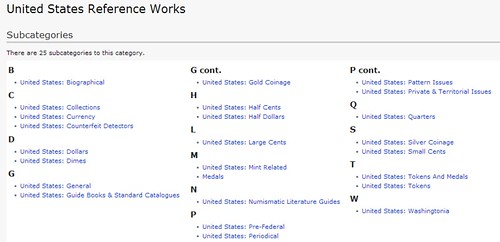
When the Top 100 was originally put up on the Wiki, I wanted to get the information out there first, and then fiddle around in the background doing the real work of making it actually useful. A Wiki is not designed to be hierarchical and lists of items do not work well.
Every page in the U. S. portion of the site has now been rewritten and categorized, and the category listings are on the bottom of every page. Now, one page can belong to U. S. Quarters, Silver Coinage and also have an entry in the NBS Top 100 categories. No longer are three separate index lists being maintained as the category pages are dynamic. This will greatly aid in the usability of the site as we continue to add information as things will be easier to locate and the site in general becomes more useful.
The location of the category page is not ideal and I am still trying to determine where to locate it, but in the interim, here is the direct link: wiki.coinbooks.org/index.php/Category:United_States
To view the lists of The One Hundred Greatest items of United States Numismatic Literature, see:
wiki.coinbooks.org/index.php/The_One_Hundred_Greatest_Items
_Of_United_States_Numismatic_Literature
SMITH'S AMERICAN NUMISMATIC BIOGRAPHIES UPDATED
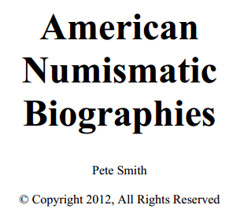 American Numismatic Biographies was first published in 1992 and included about 1400 biographies. Just 100 copies were printed so it had a very limited distribution.
American Numismatic Biographies was first published in 1992 and included about 1400 biographies. Just 100 copies were printed so it had a very limited distribution.
The current draft of (ANB has been added to the NBS website and is now available to anyone. It now includes more than 1700 biographies of people who have made an important contribution to American numismatics.
One reason for posting this is to allow any of the subjects to review their listing and offer updates or corrections. Readers may also suggest additional names for inclusion. The address to send changes is at the bottom of every page of the listing. NOTE: the email address for responses has changed and anything sent to the old address in recent months was not delivered.
To access ANB, use the direct link below or
- Go to the NBS website at www.coinbooks.com
- Click on "Community Resources"
- Click on the link anb_2012.pdf
At the top of the page is a box marked "Find" This may be used to search for any term or name. Names are in the format Last, First.
This is a work-in-progress covered by copyright protection. It may not be copied or distributed. The website will be updated periodically as the document is modified.
To view American Numismatic Biographies, see: www.coinbooks.org/resources/anb_2012.pdf
KOLBE & FANNING HOLD WEEK-LONG “BLACK FRIDAY” SALE
 Kolbe & Fanning Numismatic Booksellers have announced that they will be holding a week-long “Black Friday” sale on their website at
www.numislit.com
. The sale will begin on Friday, Nov. 23 and last until Friday, Nov. 30. During that time, all items on the Kolbe & Fanning website will be available for 20% off the listed price. In addition, domestic orders will be shipped for a flat fee of $5 per order, regardless of the number of books included. (International shipments will continue to be billed at the actual cost.)
Kolbe & Fanning Numismatic Booksellers have announced that they will be holding a week-long “Black Friday” sale on their website at
www.numislit.com
. The sale will begin on Friday, Nov. 23 and last until Friday, Nov. 30. During that time, all items on the Kolbe & Fanning website will be available for 20% off the listed price. In addition, domestic orders will be shipped for a flat fee of $5 per order, regardless of the number of books included. (International shipments will continue to be billed at the actual cost.)
Kolbe & Fanning regularly add material to their ever-growing website, which features works on all aspects of numismatics. Items range in price from $5 to $2000 before the 20% discount. Nearly a thousand titles are available for immediate purchase.
Kolbe & Fanning’s website can be reached at www.numislit.com .
NEW BOOK: NOTTINGHAMSHIRE VICTORIA CROSS HEROES
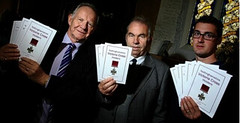 TWENTY Victoria Cross holders from Notts are commemorated in a new booklet.
TWENTY Victoria Cross holders from Notts are commemorated in a new booklet.
A total of 1,300 booklets have been produced for the Nottingham and Nottinghamshire Victoria Cross Committee. Some have been sent to families of Victoria Cross holders in this country and abroad.
The rest will be available from libraries, including those at Bingham, Blidworth and Mansfield, or by contacting the committee.
Committee chairman Tony Higton said: "Different people have told these stories before but we have delved into their lives and pulled them together to make sure they are not forgotten."
Mr Higton, along with fellow committee member Ben Percival, of Ernest Smith stonemasons, and county council deputy leader Martin Suthers, unveiled a plaque to one of the soldiers featured in the booklet at St Mary's Church, Church Street, Bingham.
The booklet – paid for by Notts County Council – has been sent to families of VC holders for whom the committee has contacts.
To get a copy, visit www.nottinghamshire-victoria-cross-memorial.org.uk and select the "contact us" section.
To read the complete article, see:
Heroic tales of Victoria Cross holders revealed in bookle
(www.thisisnottingham.co.uk/Heroic-tales-Victoria-Cross-holders
-revealed/story-17308757-detail/story.html)
RUSSELL RULAU 1926-2012
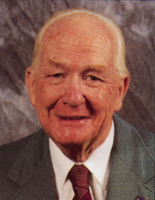 Russell Alphonse Rulau, age 86, of Iola, died Monday, November 12th, 2012 at his residence. Born Sept. 21, 1926 at Chicago, Ill., and raised during the Depression in Milwaukee, Wis., he graduated with honors from Bay View High School in Jan. 1944. Being 17 and desirous of joining the Army, he took a job at a Cicero, IL defense plant until turning 18, then volunteered for Army service at Fort Sheridan, IL. After 17 weeks' infantry reconnaissance scout training at Camp Fannin, Texas, he was shipped to the Pacific theater and volunteered for airborne training, completing jump/glider school in Luzon and was assigned to 187th Infantry, 11th Airborne Division, serving therewith until July, 1947 on Luzon, Okinawa, Honshu and Hokkaido.
He often stated the high point of his service came July 30, 1945 when he was assigned to General Macarthur's arrival honor guard from among the first combat troops to reach Japan at Atsugi Field the evening before.
Russell Alphonse Rulau, age 86, of Iola, died Monday, November 12th, 2012 at his residence. Born Sept. 21, 1926 at Chicago, Ill., and raised during the Depression in Milwaukee, Wis., he graduated with honors from Bay View High School in Jan. 1944. Being 17 and desirous of joining the Army, he took a job at a Cicero, IL defense plant until turning 18, then volunteered for Army service at Fort Sheridan, IL. After 17 weeks' infantry reconnaissance scout training at Camp Fannin, Texas, he was shipped to the Pacific theater and volunteered for airborne training, completing jump/glider school in Luzon and was assigned to 187th Infantry, 11th Airborne Division, serving therewith until July, 1947 on Luzon, Okinawa, Honshu and Hokkaido.
He often stated the high point of his service came July 30, 1945 when he was assigned to General Macarthur's arrival honor guard from among the first combat troops to reach Japan at Atsugi Field the evening before.
He reenlisted in 1947 and was assigned as an Army recruiting sergeant in Milwaukee, being discharged April 27, 1950. He joined the newly-formed USAF Reserve April 28, 1950 and was called to active duty for the Korean War Oct. 22, 1950, remaining with the Air Force until Dec. 17, 1962. Then he rejoined the Air Force Reserve through May 2, 1973, though he was not called for Vietnam War service. His rank was Master Sergeant.
The most important duties he performed in the Cold War Air Force was as Noncommissioned Officer in Charge of the Intelligence Message Branch of United States Air Forces Europe (USAFE) in Germany 1958-59 and as sergeant major of a combined Army-Navy-Air Force-Atomic Energy Commission nuclear unit in New Mexico during the Cuban missile crisis of October, 1962.
Though lacking formal education, he began a long career as writer-editor- author-consultant in the numismatic field beginning in December, 1962, rising from staff writer to full editor in just nine months with Amos Press, Sidney, Ohio. He joined Krause Publications as a newspaper editor in April 1974, taking early retirement August, 1984 and becoming a self-employed author and consultant. He was appointed in 1985 by England's Pobjoy Mint as vice president of U.S. sales operations, leaving this service in December, 1998. He received awards from Presidents Nixon, Reagan and Bush I, and from Governors Dreyfus and McCallum. In 1993 he was awarded the Clemy, highest honor of the Numismatic Literary Guild; was made a Fellow of the American Numismatic Society, New York in 1999, and was inducted into the Numismatic Hall of Fame in Colorado Springs in 2000.
A Republican from age 15 onward, he served as Waupaca County GOP vice chairman 1977-79; chairman 1979-82; 3rd vice chairman of the Wisconsin GOP 1981-83.
The son of Alphonse Rulau and Ruth Terine Thorsen, he married Darlene Grizzell on Feb 1, 1968 in Sidney, Ohio. She preceded him in death in 2008. He is survived by nine children, 20 grandchildren and four great-grand children. Darlene died in 2008. He was a life member of the VFW and commander of its Iola post for eight terms, Also active in the American Legion, 11th Airborne Division Association and 187th RCT (Rakkasans) association. His favorite charities were the Salvation Army and a Russian couple he hosted in the U.S.A. in 1992.
He has long been considered the number one token authority in the United States and Latin America and has written extensively on all numismatic subjects from ancient times to the present, with 17 books to his credit. In early 2006 he began a new career path with Krause Publications, authoring an Internet catalog of all U.S. tokens from 1700 through 1900.
A Memorial Service will be held at Our Savior's Lutheran Church in Iola at 11:30 am on Friday, November 16th, with Reverend Dennis Olson officiating. Memorial Visitation will be held Friday 10:30 am - 11:30 am. at the church. Interment of Cremains with full Military Rites will be in the Central Wisconsin Veterans Memorial Cemetery in King, Wisconsin. Register Book and online condolences may be sent by visiting www.voiefuneralhome.com
To read the complete obituary, see: Russell Alphonse Rulau (www.voiefuneralhome.com/fh/obituaries/obituary.cfm?o_id=1816255&fh_id=12037)
My interactions with Russ Rulau date back through roughly 50 years. My recollection is that our first contact probably came at Riverside, California, back in February of 1962. The occasion would have been a gathering of the then Southern California Exonumist Society, hosted at the historic Mission Inn in that city, which I availed myself of while on a driving tour through the southwest and the west coast. Over the next couple years we exchanged letters on several occasions, next meeting over lunch at a 1963 late winter coin show in Cleveland.
We were both possessed of deep involvements in the then emerging blossoming enthusiasm for collecting in the exonumia realm. Our Cleveland meeting was occasioned by his desire to divest himself of editorship of the Journal of the Token and Medal Society, given his recent acceptance of a staff writer position at Coin World. That meeting turned out to be roughly coincident in timing with my having committed to taking up a similar position with Numismatic News. Ultimately, editorship of the Journal passed from Russ into the hands of Alfred Hock that fall, who held the position for roughly a year, with me picking it up in the fall of 1964 and holding it through 1968.
The ten years that passed between our 1963 meeting and Russ’ joining the Krause Publications staff in early 1974 found us frequently crossing paths on the numismatic trail as a consequence of our professional travels, including ongoing interaction where our mutual interests where the welfare of the exonumia field and the Token and Medal Society were concerned. For his part, Russ was the father of the term exonumist; combining the meaning of “exo” -- “without or outside” -- and the abbreviation “numis” for numismatics, thus “outside the usual or conventional phases of numismatic activity.” I on the other hand was among the 13 enthusiasts met in Detroit on November 19, 1960, of whom only Dave Bowers, Tom Fruit and myself survive, to give birth to the organization today known as the Token and Medal Society.
In 1974 Russ joined the Krause staff as editor of the recently launched World Coin News. He played an integral role in the development and growth of the publication and related world coin reference works released over the next ten years. Leaving the company to become a self-employed author and consultant in the numismatic field in the summer of 1984, in 1985 he began 13 year association with the Pobjoy Mint in a sales and marketing capacity for the United States. Having retired from the Pobjoy post at the end of 1998, since then much of his time was again spent in pursuit of authorship and consulting tasks, with our paths crossing frequently at the company and around Iola until recent years.
Russ was a widely recognized researcher, cataloger and author in the U.S. and Latin American token realms, having authored a variety of articles and many references, some in several editions, for Krause Publications, culminating with publication of the Standard Catalog of United States Tokens, embracing three centuries from colonial times to the close of the 19th century, released in several editions over the years. Less well recognized is the fact that he was a motivational force behind the development of the Coin of The Year program conducted annually by Krause Publications, for which the first awards embraced the issues of 1982 which were presented in 1984 after he had separated from the company.
I personally found Russ to be a most interesting and intense individual. He possessed a very high degree of certainty and assurance, sometimes to a fault. This often tended turned people off. What one could always expect from him, however, was a commitment to delivering the goods as he was able to devolve them given the available resources. Possessing a militaristic bent, he was always prepared to defend with apt reasoning his or the company’s positions against all comers. This also came through in Russ’ political and fiscal persuasions, he being a conservative Republican and precious metals advocate of the highest order.
Always boiling beneath the surface was a driving conviction, I would say, to contribute as best he might towards the well-being of our hobby community, the country and mankind.
I will miss what had become increasingly infrequent interactions with Russ in more recent years as our paths diverged and his health declined.
He liked to be able to earn a living in the field that he had first fallen in love with in 1939, the year he turned 13. But World War II interrupted and rerouted his life as it did those of millions of others. His time in the military stretched on for nearly 20 years before he got the chance to earn a living in numismatics when he joined the staff of Coin World at the end of 1962. That made him a competitor of Numismatic News. But more importantly it made him a professional in the field that he had always loved. He got paid for it.
I learned quickly that he was proud of the fact that he had invented the word “exonumia” to label the collecting of non-coin and non-paper money items like medals, tokens and wooden nickels, but his major contribution to numismatics occurred in the world coin field where he was editor of two important periodicals. The first was World Coins magazine that he started and headed 1964-1974. He ceased being a competitor and joined up with Krause Publications to help get World Coin News started properly in 1974.
To read the complete article, see: Rulau happy to go where hobby led (www.numismaticnews.net/article/rulau-happy-to-go-where-hobby-led)
RULAU'S AMERICAN TOKEN FINDER COLUMNS SOUGHT
Token and Medal Society President John Mutch writes:
With the passing of Russell Rulau, I am reminded of a project I have wanted to pursue. He wrote a series in Coin World called "The American Token Finder" - sections that I am aware of were in the early 1970s. I don't believe that much of the information he presented ended up in his United States Tokens book. I am wondering whether any E-Sylum readers know of a clipping file of the entire series that could be borrowed?
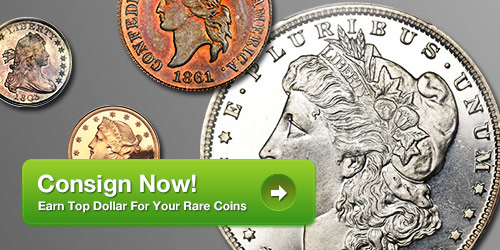
THE SOUTHERN CALIFORNIA ORDERS & MEDALS SOCIETY

Frank Draskovic, President of the Southern California Orders & Medals Society (SOCALOMS) writes:
As you've been publishing so much great stuff on medals, I'd like to ask permission to copy and re-publish the occasional article on medals in our monthly newsletter (actually the monthly medal meeting reminder) of the Southern California Orders & Medals Society. We're a small, but old...now over fifty years in existence...group who have been meeting regularly each month in the Los Angeles area (we think possibly longer than any other medal society) to talk about and exhibit worldwide Orders, Decorations & Medals...ODMs, i.e., mostly portable (wearable) medals, and of those mostly military, but increasingly table medals too as we seek new members to keep the group viable in the internet age and for reasons of attrition.
We always meet on the last Sunday of each month from 12 noon to about 3 or 4pm at an attractive venue at a golf country club in a Los Angeles area suburb and everyone has a fine time.
I'd like extend an invitation on our behalf to any Los Angeles area medal collector who might like to attend a meeting to check out our activities (several drive from San Diego each month and have doing so for many years). All we ask is that a guest contact us first so we know who's walking in the door and they can do that by emailing me at
Sounds like a fun club - I've never lived in a town with a club dedicated to Orders & Medals. E-Sylum are encouraged to visit. -Editor
For more information about SOCALOMS, see: home.earthlink.net/~socaloms/
MORE ON CONTEMPORARY COUNTERFEITS
This is a good question and goes back to times when coins, or at least certain types of coins, were in circulation much longer than today. I don't think there is an official definition, but "contemporary counterfeit" usually is used to describe a coin as "counterfeit during the time in which this coin type was used as a means of payment, with the intention of passing it along as good money". It is opposed to the term "modern counterfeit", which is usually describing a production, usually but not necessarily of recent times, which has been made to fool collectors.
For obvious reasons, "contemporary counterfeits" have lost their importance nowadays with the predominance of fiat money. I don't know if fake paper money would be called "contemporary counterfeits" as well (it may well be in an hundred or so years down the road). Of course, counterfeits of circulating coins are still made - the British pound being a vivid example. A recent example of counterfeits being caused by metallic content would be the mid-1990s 10 pesos coins of Mexico. For a while, these coins were made bimetallic with a silver core, and people took out this central part and replaced it with a less valuable metal.
Of course, there were also counterfeits - and fantasy issues - of ancient coins made for collectors in medieval times. Admittedly, these items won't fit the above definition, which is not scientific by any means anyway.
To read the earlier E-Sylum article, see: HOW CONTEMPORARY WERE 'CONTEMPORARY COUNTERFEITS'? (www.coinbooks.org/esylum_v15n47a09.html)
GRIMASON'S THEORY ON THE 1776 CONTINENTAL CURRENCY COINAGE
Benjamin Franklin designed and made the original coins in secrecy at night at the Soho Mint in 1775 with the help of a select few of his most trusted and intelligent peers.
The original continental currency coins were a mathematical scientific experiment of sorts in hopes of preventing counterfeiters from counterfeiting coins each man contributing his specialized expertise. Murdock invented gas lighting which enabled them to work at night others specialized in working with the makeup of metal compounds and silver plating small copper objects, etc.
They may have been originally intended as coinage but Franklin was unable to receive a loan of silver he was expecting from France and when it didn't come through he put the idea of a continential currency on the back burner and the examples they had made were presented to influential people perhaps the government officials for each state., members of Congress or grand masters of masonic lodges ....this I am not sure of at the moment it is one of the missing clues I am still looking for.
There was at least one coin made of copper (there may have been some in brass and perhaps tin that I am not sure about and I have not been able to find any facts to support it )
At least one copper coin was plated with silver but I don't think any were made of pure silver and again I have found no facts.
The newer looking coins struck in pewter and in a collar were made years later by example of the original coins. The original coins were made before the bills were engraved. Elisha may have received one of the originals from Franklin, which is how he was able to engrave the paper bills.
One of the coins that was struck later in years may have been designed using the paper bills Elisha Gallaudet engraved which is why it says EG FECIT but again I have yet to find anything in support. But it makes a lot more sense than to assume Elisha redesigned the coin 5 times and struck 6000 copies without a mint and without anyone knowing they existed.
To read the earlier E-Sylum article, see: RESEARCHERS STUDY THE 1776 CONTINENTAL CURRENCY COINAGE (www.coinbooks.org/esylum_v15n47a22.html)
NOTES FROM E-SYLUM READERS: NOVEMBER 18, 2012
Walter H. Childs Biography Sought
Researcher Roger Burdette writes:
Does anyone have a copy of the Walter H. Childs coin auction catalog from Bowers & Merena, Aug 1999? If so, can I get a copy of the multipage biography of Childs that is included? I'll reimburse copying and postage fees. Thanks.
Weinberg's November 2012 Baltimore Show Report
Alan V. Weinberg writes:
The show bourse was sold out- quite unusual - and attendance by the public was grand, reminiscent of years ago shows. Roaming the bourse floor, I heard nary a complaint or whisper about sales although several dealers told me many dealers are capital-strained or short. Once again, Whitman put on a well-organized and heavily attended show.
The Stacks-Bowers colonial session of 1000 lots Friday night started at 6 PM and went to 3:30 AM. - perhaps a record for a numismatic auction session. I left at 8 PM, being pooped from roaming the concrete bourse floor but up to that time the Internet bidding, despite a heavily occupied bidder floor, dominated the sale. As I recall, the "dug" partially sheared New England sixpence hammered for $375K and the George Clinton cent in Fine hammered for $190K- I think both to the Internet. That's not including the 17.5% buyers fee.
From my experience there Wed-Sat, the hobby is healthy and still very enjoyable
More on the 1814 Platinum Half Dollar
Saul Teichman writes:
 With regard to the Platinum half dollar, I do not know why PCGS slabbed this as a J44a as having it counterstamped and engraved does not make it a new variety. Even worse, no one knows where or when this counterstamping and engraving
occurred. Because of this, it is not likely that it will be listed as a separate variety in the next edition of the Judd book.
With regard to the Platinum half dollar, I do not know why PCGS slabbed this as a J44a as having it counterstamped and engraved does not make it a new variety. Even worse, no one knows where or when this counterstamping and engraving
occurred. Because of this, it is not likely that it will be listed as a separate variety in the next edition of the Judd book.
To read the earlier E-Sylum article, see: PATTERN 1814 PLATINUM HALF DOLLAR WITH PUNCHMARKS (www.coinbooks.org/esylum_v15n47a11.html)
Fort Bliss Medal V-2 Rocket Testing
Regarding the Fort Bliss medal, Greg Adams writes:
The image on both the stamp and the medal are of the V-2 Rocket Testing that was conducted at the White Sands Missile Range post 2nd world War. (1946 into the early 1950’s). If he has not already would suggest that Mr. Rightmire contact the museum & historical society at the missile range. Contact information can be found at: www.wsmr-history.org/Museum.htm
In Search of Raymond Ladd
Regarding Larry Gaye and his search for JSD Numismatic Publications and Raymond Ladd, Dan Demeo writes:
I don't know Raymond Ladd, but JSD also were dealers in ancient coins. Two people, Jack Glowe and Dennis Tupper operated JSD in the 1970's out of Orange County, CA. I haven't seen Dennis in years, but did run into Jack a few years ago. I'm sure I could find him, but I'll let Larry do some of the search. Last I knew, Jack Glowe (the J in JSD) was living in Orange County, in the Costa Mesa - Fountain Valley area, still interested in coins (I ran into him at a coin show, where else?). Now I'm going to have to tear apart my not-as-organized-as-it-needs-to-be library, looking for my copy of Ladd's book--I haven't seen it in years.
To read the earlier E-Sylum article, see: QUERY: GUIDE TO ANCIENT NUMISMATICS AUTHOR RAYMOND LADD SOUGHT (www.coinbooks.org/esylum_v15n47a15.html)
Guide to Indian Paper Money Editions
Joe Boling writes:
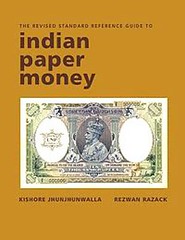 In reference to The Revised Standard Reference Guide to Indian Paper Money - I don't understand the publication date shown (8 November 2012), as the book was released to the hobby at a grand ceremony on 13 January 2012. Don't get rid of your first edition. It showed more notes with more information for Junagadh and Kutch, and more illustrations of backs for Palitana.
In reference to The Revised Standard Reference Guide to Indian Paper Money - I don't understand the publication date shown (8 November 2012), as the book was released to the hobby at a grand ceremony on 13 January 2012. Don't get rid of your first edition. It showed more notes with more information for Junagadh and Kutch, and more illustrations of backs for Palitana.
While the new edition is a great piece of work, it has some deficiencies - such as no index, and lack of any kind of rarity or value information for the pieces listed. The two-page table of POW camp issues at pages 454-455 contains no data (an errata sheet is promised "once the data is completely tabulated" - that promise came last February, but no errata sheet has appeared). In several places the text assumes an understanding of jargon associated with Indian notes, with no glossary or other explanation. By all means buy the book, but be prepared to scratch your head a few times.
The book is available at this website for $180 postpaid (not the $200 in the Press Release that you referred to):
www.vedamsbooks.com/no109373/revised-standard-reference-guide-
indian-paper-money-rezwan-razack-k-jhunjhunwala
Incidentally, the photo of five volumes in the book listing for that title is misleading - it's a single volume. Mine is nicely slipcased - I assume all are.
To read the earlier E-Sylum article, see: NEW BOOK: GUIDE TO INDIAN PAPER MONEY (www.coinbooks.org/esylum_v15n47a03.html)
More Books on Shanghai Tokens
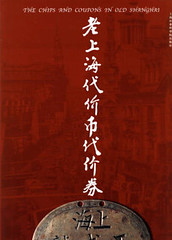 Bruce W. Smith writes:
Bruce W. Smith writes:
Regarding the book, Chips & Coupons in Old Shanghai by Pan Junxiang - this is the third book I know of on Shanghai tokens. The first, by Hu Youwen, was published in 1991. This book is a poorly printed paperback and illustrated with rubbings. The second book, by Ma Chuande, was published in 1998. This is hardcover and illustrated with nice color photos. All three books are in Chinese. There is also a catalog of merchant scrip (paper money) issued in Shanghai during 1938-1940. The eBay seller, coinsxzh, carries many numismatic books, including books on Chinese stocks & bonds, ration coupons and Mao badges. I have successfully ordered a few books from him, but his prices and shipping charges are very high.
To read the earlier E-Sylum article, see: BOOK REVIEW: CHIPS AND COUPONS IN OLD SHANGHAI (www.coinbooks.org/esylum_v15n47a07.html)
Thomas William Kinder Biography
Bruce W. Smith writes:
Regarding Thomas Kinder (1817-1884), who was in charge of the Hong Kong Mint and then the Osaka Mint, there is a biography in English: Thomas William Kinder and the Japanese Imperial Mint 1868-1875, by Roy S. Hanashiro, Brill Academic Publishing, 1999 (234 pages). I haven't seen the book, so I can't comment on it. I believe it is available through Amazon.com.
It is indeed available on Amazon, where I found the cover image and description below.
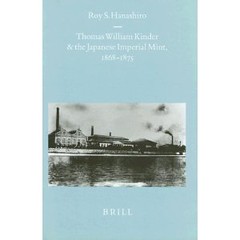 An analysis of the phenomenon of the Japanese adopting Western technology but resisting foreign domination during Meiji Japan, at the hand of the formative period of the Japanese Imperial Mint. The author thereby offers a prime historical study on the interaction between the Japanese government and the West, and its underlying sentiments. Examining the governmental reforms along Western lines, the transfer of Western technology and the hiring of foreign experts, it is examined how, at the Imperial Mint, this process was wholely dominated by the British. Focusing on the role of the director of the Mint, Thomas William Kinder, the author concludes that Kinder was much more than a mere technocrat but a key player in the decision-making process. This very fact, the volume clearly points out, was the major factor leading to the removal of these foreign experts from the Mint.
An analysis of the phenomenon of the Japanese adopting Western technology but resisting foreign domination during Meiji Japan, at the hand of the formative period of the Japanese Imperial Mint. The author thereby offers a prime historical study on the interaction between the Japanese government and the West, and its underlying sentiments. Examining the governmental reforms along Western lines, the transfer of Western technology and the hiring of foreign experts, it is examined how, at the Imperial Mint, this process was wholely dominated by the British. Focusing on the role of the director of the Mint, Thomas William Kinder, the author concludes that Kinder was much more than a mere technocrat but a key player in the decision-making process. This very fact, the volume clearly points out, was the major factor leading to the removal of these foreign experts from the Mint.
To read the earlier E-Sylum article, see: THOMAS KINDER AND THE HONG KONG MINT (www.coinbooks.org/esylum_v15n47a31.html)
More on the Italian Coin for the 150th Anniversary of the Lira
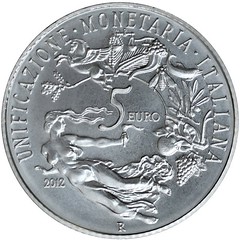 Bruce W. Smith writes:
Bruce W. Smith writes:
Regarding the Italian coin for the 150th anniversary of the Lira - the designs on the reverse are all taken from various Italian coins from that period -- the flying woman, flying horse, grapes, etc.
To read the earlier E-Sylum article, see: SOME NEW COIN DESIGNS: NOVEMBER 11, 2012: Italy 5 Euro coin on 150 years of Lira (www.coinbooks.org/esylum_v15n47a26.html)
Million Dollar Publicity
David Alexander writes:
The recent recollections of the Million Dollar display at the Seattle World's Fair recall another era in the growth and development of Coin World. The lavish publicity accorded to what was little more than an enormous heap of silver coins piled on a floor mirrored the paper's desperate need for copy. When the founding editor, knowledgeable numismatist, D. Wayne Johnson, was ousted, there was a spell without a whole lot of real numismatic leadership at CW, and much was made of such marginal items as the Behlen pile, that was made into what the kids call a B.F.D.
To read the earlier E-Sylum article, see: 1962 SEATTLE WORLD'S FAIR NUMISMATIC SOUVENIRS (www.coinbooks.org/esylum_v15n45a08.html)
QUERY: REVIEWS OF BOOKS ON MINT AND COINS OF UKRAINE SOUGHT
Yosef Sa'ar of Elat on the Red Sea writes:
You have wonderful readers/contributors. Now, I'd like to ask something much more difficult. I don't even know if you cover foreign language numismatic literature. The following are two coin/token books from the Ukraine:
- Максим Загреба. Монети України 1992-2011. Каталог. Київ, 2012.
- А.С.Люлько. ЛСЗ - первый монетный двор Украины. Луганск, 2005.
Translated, this would be:
- Maxim Zagreb. Coin of Ukraine 1992-2011. Catalog. Kiev, 2012.
- A.S.Lyulko. LSZ - First Mint of Ukraine. Lugansk, 2005.
Anyone have these?
QUERY: EVER HEARD OF THE 7 1/2 CENT "COCA COLA" COIN?
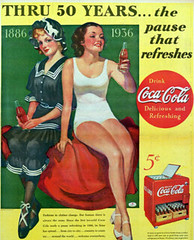 Prices change; that's fundamental to how economies work.
Prices change; that's fundamental to how economies work.
And yet: In 1886, a bottle of Coke cost a nickel. It was also a nickel in 1900, 1915 and 1930. In fact, 70 years after the first Coke was sold, you could still buy a bottle for a nickel.
Three wars, the Great Depression, hundreds of competitors — none of it made any difference for the price of Coke. Why not?
In 1899, two lawyers paid a visit to the president of Coca-Cola. At the time, Coke was sold at soda fountains. But the lawyers were interested in this new idea: selling drinks in bottles. The lawyers wanted to buy the bottling rights for Coca-Cola.
The president of Coca-Cola didn't think much of the whole bottle thing. So he made a deal with the lawyers: He'd let them sell Coke in bottles, and he'd sell them the syrup to do it. According to the terms of the deal, the lawyers would be able to buy the syrup at a fixed price. Forever.
Bottled drinks, of course, took off. And Coca-Cola was in a bind. If the bottlers or a corner store decided to raise the price of a bottle of Coke, Coca-Cola wouldn't get any extra money.
So, if you're Coca-Cola, you want to somehow keep the price down at 5 cents so you can sell as much syrup as possible to the bottlers. What do you do?
"One thing you do is blanket the entire nation with Coca-Cola advertising that basically has '5 cents' prominently featured," Young says.
The company couldn't actually put price tags on the bottles of Coke saying "5 cents." But it could paint a giant ad on the side of a building right next to the store that says, "Drink Coca-Cola, 5 Cents."
That contract with the bottlers eventually got renegotiated. But the price of Coke stayed at a nickel. That was partly due to another obstacle: the vending machine.
The Coca-Cola vending machines were built to take a single coin: a nickel.
Levy says the folks at Coca-Cola thought about converting the vending machines to take a dime. But doubling the price was too much. They wanted something in between.
So they asked the U.S. Treasury to issue a 7.5-cent coin. At one point, the head of Coca-Cola asked President Eisenhower for help. (They were hunting buddies.) No luck.
In the end, inflation killed the nickel Coke. The price of the ingredients rose. In the late 1940s, some stores sold Cokes for 6 cents. The last nickel Coke seems to have been in 1959.
To read the complete article, see:
Why Coke Cost A Nickel For 70 Years
(www.npr.org/blogs/money/2012/11/15/165143816/
why-coke-cost-a-nickel-for-70-years)
I checked in with researcher Roger Burdette, who writes:
I'm aware of several efforts to have odd-denomination coins minted, but I have not collected any specific information on the Coke Co. proposal. There are several mint files in NARA College Park dealing with coin proposals. Someone might want to check them.

REJECTED COIN DESIGNS
Rejected coin designs take on a life of their own. This week we learn of a rejected coin design from Ireland that is featured in a museum exhibit that illustrates the history of Ireland in 100 objects.
The coin model, prepared in 1926, shows a charming little boy described as "scampish" in the article appearing in the Irish Times this week. The coin model was from a coin competition of 1927 that led to the first national Irish coinage with coins struck in 1929.
A committee, led by Irish poet William Butler Yeats, was charged with choosing eight new coin designs and selecting a sculptor to create the models. They chose animals and a fish native to Ireland as the motifs for each of the eight denominations and selected nine artists from six countries to enter a closed (invitation only) competition.
 Irish-born sculptor Jerome Stanley Conner stepped outside the rules -- disregarding the recommended animal -- and created a model for the penny bearing that Irish youth now on exhibit at the National Museum of Ireland. Conner, who had left Ireland at age 14, came to America. He became proficient in sculpture specializing in monumental work in his studio in Washington DC. He had returned to Ireland in 1925 before the invitations to compete were issued.
Irish-born sculptor Jerome Stanley Conner stepped outside the rules -- disregarding the recommended animal -- and created a model for the penny bearing that Irish youth now on exhibit at the National Museum of Ireland. Conner, who had left Ireland at age 14, came to America. He became proficient in sculpture specializing in monumental work in his studio in Washington DC. He had returned to Ireland in 1925 before the invitations to compete were issued.
The artist felt the penny was a child's coin. His design reflected this by celebrating a childhood theme according to the Irish Times article. This also brought to mind the harsh times in Ireland's history where Irish families gave up their children to be housed in institutions because they were poor. The article expands on this.
[I looked up Conner (1875-1943) in my American Artists Databank. He is listed. I found such tidbits as he was a one-time prize fighter, his name was often misspelled Connor -- OR -- even in his obituary in the New York Times (August 22, 1943), and it is listed both ways in biographical dictionaries Fielding (1926) and Falk (1999). Also I had sold in one of my auctions a galvano relief he had created of Walt Whitman.]
In June 2011 Ed Reiter wrote an article of the subject of this coin competition from the viewpoint of one of the rejected artist's models -- those of Italian Publico Morbiducci. He records all artists who were invited in addition to the Italian Morbiducci -- Americans Paul Manship, James Earle Fraser, and Ivan Mestrovic. Fraser declined to participate, Mestrovic received the invitation late and only submitted a model of the Irish harp to be common on all eight coins.
In addition to Conner, Irish sculptors Albert Power and Oliver Sheppard were invited. Also Carl Milles of Sweden and Percy Metcalfe of England. Metcalfe won the competition and the others received a 50 pound compensation.
Reiter's article records the sales of Morbiducci's rejected models over the years. Manship was, perhaps, more aware of his position in the art field. He donated a set of his rejected models to the Metropolitan Museum of Art in 1929, the year Metcalfe's designed coins were released. He donated his studio set of the eight coin models to the Smithsonian Art Museum (among other studio models) in 1965 a year before his death.
While Morbiducci's models have infrequently appeared in the numismatic and art fields we have knowledge of other rejected coin models. The competition for the Washington quarter, resulting in the 1932 Flanagan design, attracted hundreds of other artists' models.
We all know the story of Laura Gardin Fraser's Washington model for this competition which was resurrected in 1999 for the $5 commemorative gold on the bicentennial of Washington's death. Both her obverse and reverse models were revived for this modern U.S. commemorative.
The U.S. Treasury returned all unaccepted models. Many of those 1932 competition rejected models remained in sculptors' studios. When their estates are sold these come on the market. Those models by New York sculptor Thomas Cremona bounced around the New York City market for some time. NASCA sold one in their auctions, I sold another.
There are many stories of what happens to unaccepted coin models. They take on a life of their own.
To read Ed Reiter's article:
AN ITALIAN ARTIST’S LEGACY TO IRISH NUMISMATICS
(www.coinnewstoday.com/article2/97-an-italian-artists-legacy
-to-irish-numismatics.html)
To access the Irish Times article by Fintan O'Toole click on: Rejected coin design, 1926 (www.irishtimes.com/newspaper/weekend/2012/1117/1224326693688.html)
WASHINGTON POST ARTICLE ON LOCAL CURRENCY
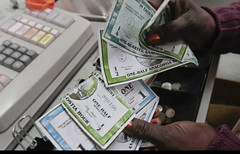 One recent Saturday morning, Nick Williams navigated the packed aisles of the Glut Food Co-Op in Mount Rainier, filling his basket with organic vegetables, herbal tea, turmeric and local apple cider.
One recent Saturday morning, Nick Williams navigated the packed aisles of the Glut Food Co-Op in Mount Rainier, filling his basket with organic vegetables, herbal tea, turmeric and local apple cider.
After the cashier rang up his purchases, he pulled out a funny-looking piece of paper instead of a wad of cash. The bill had environmentalist Rachel Carson’s picture where Abraham Lincoln’s ought to have been. Stripped across the top was the motto “In Each Other We Trust.”
Monopoly money? No, just a local currency system in the Mount Rainier and Hyattsville neighborhoods in Prince George’s County, where users essentially trade goods and services using money the group designed and printed called “Anacostia Hours.”
Local or alternative currencies are almost as old as trade itself, but the movement has found new life amid the global financial crisis, as parallel economies outside the traditional monetary system have emerged in countries such as Spain, Mexico and Brazil. These systems are flourishing because the unemployed can either trade skills for local currency or swap their time for other services.
Supporters of local currency in the United States say they are founding these systems here because they believe in the “buy local” movement and want to strengthen their neighborhoods and reduce reliance on large corporate banks.
“Obviously the idea of local currency has been around for a long time and historically they do pop up in times of economic uncertainty,” said Julie Gouldener, 40, program coordinator of the Baltimore Green Currency Association. “We view the complementary currency as a win-win. It’s not meant to replace the U.S. dollar. It’s meant to exist alongside it and build more local wealth.”
Gouldener’s group launched a currency called the BNote in April 2011. Locals can trade real dollars for BNotes at eight “cambios” around the city, including Zeke’s Coffee in Northeast Baltimore, and use them at 175 businesses. So far, there are about 28,000 BNotes in circulation.
Collom said that currency systems are more likely to falter because organizers find it difficult to sustain momentum. Even the Ithaca Hours has seen a decline in usage, with the number of participating businesses falling from about 500 at its height to about 200 now. Its new board president, Paul Strebel, a financial adviser, said he hopes to reinvigorate the system and is exploring using virtual bills on smartphones.
Feeling like he needed to do something to help in the country’s economic downturn, District artist Larry Chang, 63, began making local money he called Potomacs in 2009, currency that eventually was accepted in places such as Qualia Coffee in Petworth. But after a good start, the movement lost steam, Chang said.
“It hasn’t caught on very well,” he said. “In D.C. it was very hard to put something across that’s alternative.”
In the neighborhoods surrounding Mount Rainier, however, the Anacostia Hours program has been a small but steady presence since it was founded in 2006. There are now 76 members, who pay $5 each in annual dues and provide everything from yardwork to pet-sitting to nutritional consulting, Williams said.
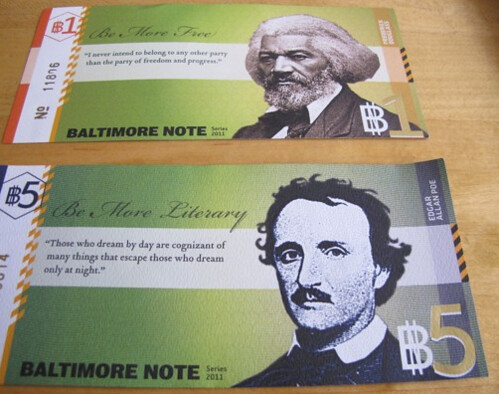
To read the complete article, see:
Monopoly money? Nope, just local currency
(www.washingtonpost.com/local/monopoly-money-nope-just-local-currency
/2012/11/12/56909b3c-29cf-11e2-b4e0-346287b7e56c_story.html)
2013 PARIS AND MADRID ROUNDTABLES ON SMALL CHANGE
Georges Depeyrot writes:
I remind you the two round tables in Paris and Madrid concerning The small change (from Antiquity to 19th c.) and The transfers of precious metals (from 16th c. to 19th c.) in May 2013. All regions in the world are concerned. Abstract are to be sent now. Some grants for the participation are available. All details on www.anr-damin.net
A special Round Table on “small change” (bronze/copper coins from Antiquity to 19th c.) at the Ecole Normale Supérieure, Paris, (May 13-14) in cooperation with IDHE (Institutions et dynamiques historiques de l’économie).
The idea is to analyze the importance of the small coins such as copper, bronze, billon in the development of the economy and the relations between the development of this coinage and the general economic development (including relations with banknotes, railways, minting systems, etc.) from Antiquity to 19th century.
Papers concerning all the monetary systems are welcome, from Antiquity to 19th c., from all the regions of the world, but must concern subsidiary coinage (mainly copper, bronze, tin, zinc, etc. coins). Papers focused on precious metals, on subsidiary money (cowries, salt money, paleo-moneys), or on banknotes will be refused.
This workshop will be followed by a second workshop in Madrid at the end of the same week (May 16-17). The Madrid one will be focused on the transfers of precious metal from 16th to 19th c. see Madrid workshop presentation.
Six to eight papers will be selected and all the presentation will be video recorded and available on this website.
Abstracts must be received by Dec. 31, 2012 and the definitive program will be announced on this site in January 2013.
Among the first participants: P. Baubeau, University of Paris-Nanterre; G. Depeyrot, CNRS-ENS; C. Jefferies, City University of London; Kuroda, A., University of Tokyo; A. Ögren, University of Uppsala , etc.
There is no inscription fee. Some grants are available.
The entrance is free (at the Ecole Normale Supérieure, 45 rue d’Ulm, Paris, amphithéâtre Rataud; May 13 afternoon and 14 morning), but it is better to register.
Please register or send abstracts to Georges Depeyrot.
To register or submit abstracts, see: 2013, May 13-14, Paris: The small change: bronze/copper coins from Antiquity to 19th c. (www.anr-damin.net/spip.php?article40)
DAVE ALEXANDER'S SUPERSTORM SANDY DIARY
I finally got to read the last two issues of The E-Sylum, delayed by our visitor Sandy here in Putnam County, N.Y., until yesterday (Nov. 17). The storm arrived literally with a bang, actually three blasts, on the evening of that Monday. Transformers blew but it sounded more like a visit from Al-Qaida. We were without electricity, meaning heat, light, Email, COFFEE until late Friday of hurricane week.
When Irene visited last year we had summer weather, not this year... Train service was suspended Sunday before the storm, massive tree damage blocked roads all through the area though we only lost one evergreen. Irene took most of the likely candidates 14 months earlier.
No telephones but cell phones, making finding a place to plug in the chargers a top priority. Miracle: no water in the basement! Last year four feet. No way to reach my offices at Heritage or the American Numismatic Society. Though troubled by power outage, ANS literally "towered above the tide."
Friday was the regular meeting of the New York Numismatic Club with scheduled speaker Greg Rohan, President of Heritage. Our regular restaurant was now an indoor pool, but miraculously a replacement was found and 30 attended the meeting, glad to be out, in light, and with COFFEE!!! In times of disaster coffee becomes one of the most desperately need basic food groups!
My railroad chose Friday afternoon to resume service from the end of the line at Southeast to Grand Central. When I got to the restaurant (having continued recharging my phone on the Metro North train), the phone went off with a joyful screech from my wife Pat, "Who left the lights on!!!" Click, dead again, but we obviously had power! Crews of linemen and trucks the size of the Titanic had come up the hill in the afternoon, the truck announcing TORONTO! Lots of great help from all over the U.S. and Canada. Life resumed more or less normally on Monday the following week.
Remember the old slogan, "May you live in interesting times!"
To read the earlier E-Sylum article, see: U.S. NUMISMATISTS WEATHER SUPERSTORM SANDY (www.coinbooks.org/esylum_v15n46a02.html)
WAYNE'S NUMISMATIC DIARY: NOVEMBER 18, 2012
Tuesday was the November meeting of my Northern Virginia numismatic social group, Nummis Nova. I arrived a bit early (around 6pm) to J. Gilbert's Steakhouse in McLean, VA. Already in the bar were Eric Schena and Wayne Herndon. I ordered a drink and we had a great chat while we waited for our room to open at 6:45. Joe Levine, Mike Packard and Jon Radel joined us, and when Gene Brandenburg and Dave Schenkman arrived we were seated at our table.
It was a different room than we'd had before, a little bigger perhaps, but most importantly we had a squarish table that enabled everyone to see and speak with everyone else. It made for lively conversation as numismatic stories, catcalls and insults were hurled back and forth. Dave and Gene thought it was one of our best dinners ever. The food was great, but the company was even better. Other attendees included Roger Burdette, Julian Leidman and Dave's guest, token collector Lenny Goldberg, who told me I looked just like my picture on The E-Sylum. It was also great to see Bill Eckberg, a longtime regular who retired and moved to Florida, but has been getting back to the D.C. area on occasion for a visit.
We avoid business like the plague, but had a few items to discuss. Jon was organizing our December party, and we decided on the Mount Vernon Inn. Eric had been investigating web sites for tracking meeting invitations and RSVPs. The free sites we'd tried weren't quite cutting it. A donation from Wayne Herndon will pay the first year, and Eric and his wife Heather will set it up for us. Thanks! The last item of business was a possible medal, an idea Dave Schenkman was researching for us. There wasn't a lot of interest, so we shelved the idea for this year. Perhaps another time.
We weren't very well organized this month and hadn't picked an exhibit theme. Among the items passed around were Eric Schena's obsolete notes with unusual denominations.
Eric writes:
I brought a $7 from the Phoenix Bank of Richmond, a $15 from the Exchange Bank of Virginia at Norfolk, and a $30 from the Farmers Bank of Virginia at Richmond. I also brought a mystery 6 1/4 cent Meyer & Edlinger chit.
Dave Schenkman took the prize with his gold 1689 coronation medal. Gene Brandenburg had the understatement of the night when he told Dave the group's consensus was "NOT to melt it". Dave sent these pictures:
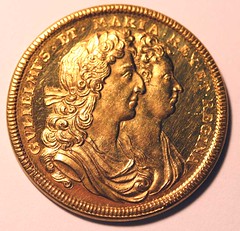

It was a great evening. It's always a pleasure to hang out with friends for a night of numismatic fellowship. You can't replicate that on the Internet.
QUERY: WILL 'SHIP OF GOLD' BECOME A FILM?
Adrián González-Salinas writes:
I found the following daguerreotype linked to the U.S.S. CENTRAL AMERICA's sinking. Regrettably, the price is expensive. This could be interesting to The E-Sylum readers.
 Coins and ingots recovered from the wreck of the S.S. Central America are now dispersed in the numismatic market. This daguerreotype is only of tangential interest - it is of one of the survivors of the disaster, banker Darius Ogden Mills and his sister. The eBay seller believes "more is more" and has piled on the text with a shovel. Follow the link to devour it all. But the part that caught my eye was this note about a possible film of the S.S. Central America story.
-Editor
Coins and ingots recovered from the wreck of the S.S. Central America are now dispersed in the numismatic market. This daguerreotype is only of tangential interest - it is of one of the survivors of the disaster, banker Darius Ogden Mills and his sister. The eBay seller believes "more is more" and has piled on the text with a shovel. Follow the link to devour it all. But the part that caught my eye was this note about a possible film of the S.S. Central America story.
-Editor
The film rights for Gary Kinder’s bestselling novel ‘SHIP OF GOLD’ were sold to Warner Brothers for $800,000.00 and Kinder has mentioned he’s writing the screenplay so we can now look forward to a film adaptation of the greatest and most impactful shipwreck in American history.
To read the complete eBay listing, see:
www.ebay.com/itm/1852-AMAZING-CALIFORNIA-DAGUERREOTYPE
-U-S-S-CENTRAL-AMERICA-GOLD-RUSH-BANKER-/110952888470
HOLABIRD-KAGIN AMERICANA DECEMBER 2012 AUCTION
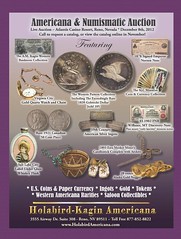 This December 8th, Holabird-Kagin Americana will hold another world-class sale of Western Americana, numismatics and collectibles at the Atlantis Casino Resort in Reno. This December's auction will feature something for just about every collector and investor, including numismatics, Americana, gold specimens, American Indian items, and saloon collectables. Below are some of the many highlights.
This December 8th, Holabird-Kagin Americana will hold another world-class sale of Western Americana, numismatics and collectibles at the Atlantis Casino Resort in Reno. This December's auction will feature something for just about every collector and investor, including numismatics, Americana, gold specimens, American Indian items, and saloon collectables. Below are some of the many highlights.
Western National Bank Notes
This incredible section features a Wibaux, Montana1902 Note in very good condition; a highly desirable and rare Emperor Norton I 50 cent note, signed by the Emperor himself; and two very rare Colorado Territory C.A. Cook & Company bank notes: a 25 cent and 50 cent, both are highly sought after by collectors. Also in this catalog section, you'll find National Gold Bank notes, of which few exist. There are several examples of fine Mormon currency going under the hammer, including a $5 and $10 notes from The Kirtland Safety Society Bank. Both are rated fine.
Numismatic Patterns and Coins
In this section, you'll find some exceedingly rare US coin Patterns like the very rare 1838 Gobrecht Judd 105 Pattern; a very rare gold dollar obverse and reverse struck from dies used to coin regular issue 1874 $1 gold piece, the very rare 1921 Canadian 50 cent piece and 1871-CC $5 in high grade.
Numismatic Ingots
This section features a large selection of silver ingots including the Jonathan Head, Amie and Climax Mine Leadville silver ingot; The Ontario (Utah) Silver Mining Company ingot, the Sweetwater MC Treasure Hill engraved trapezoidal silver ingot, the Ed A. Miller (Austin) silver ingot; the Knight & Company gold ingot; the Thomas Price & Sons Assayer ingot; and two early South American gold ingots.
General Americana
This section is loaded with history and gives the winning bidder a chance to own some of it. Featured here is a very rare and unique item, a ledger kept by the one and only General George Armstrong Custer! This ledger was kept during an assignment in Kentucky where he purchased several horses for his own racing stable. Also included in this section is a 19th century nature painting by Alfred Jacob Miller, a letter written by former First Lady Edith Kermit Roosevelt on Sagemore Hill Stationery, and the Delia Cutting photograph collection.
You also won't want to miss a major California Gold Rush archive, along with the Murphy archive--a series of letters written during this history making time when "The World Rushed In" to the Sierra foothills, up to the time when our country was a "House Divided." More historic lots in this category include an exceptionally rare Wells Fargo stock certificate signed by William Fargo, the rare embossed Mears souvenir spoon, and some exceptional miner's candlesticks, including a unique Ezra Meeker stick that is accompanied by an archive of the man's life.
Miner's Union, Railroadiana & Express
If you know about the often violent miner's union riots of the late 19th century, or if you love various Railroadiana and Wells Fargo Express items, this section is for you. We're pleased to offer several important lots of United Mine Worker's union ribbons and a large union hall bat, various railroad passes, photos, maps, and other ephemera. Especially exciting is the extraordinary Mears Silverton Railroad Pass from 1889 in beautiful condition.
Saloon and Backrooms
Last, but certainly not least, we have the saloon section which offers one of the top label under glass western whiskey flasks from Salt Lake City, a real highlight of the sale. This important bottle was buried in the Stan Sanders Collection for more than 40 years. This bottle is one of the finest Victorian western flasks you'll ever see. This sale includes everything from tokens to the rarest of whiskey and soda bottles from all 50 states. Also featured is a bitters broadside, very rare (thought to be 1 of 2 known) from the Thomas Taylor & Co. Sole Agents for their choice product. Also up for auction are three unusual "bark" bottles.
So you see, this December auction is full of variety, history and value for the historian, investor, collector and wannabe collector. The auction takes place Saturday, December 8th at the Atlantis Casino Resort 3800 Virginia Street, Reno, NV. A preview will be held on Friday, December 7th at the Holabird Office 3555 Airway Drive Ste 309 in Reno. Bidding will be live, by phone or on the internet at www.holabirdamericana.com. If you have any questions or would like to arrange a private appointment prior to the public showing, call (877) 852-8822.
Lot 116: Emperor Norton I Note
1878 - This is a note issued by THE IMPERIAL GOVERNMENT OF NORTON I. This 50 cent bond issued on 1 August 1878 promises that the bearer will be paid 50 cents in 1880 with interest at five percent per annum.
This note was chosen as one of the 100 greatest American Currency Notes by Q. David Bowers and David M. Sundman. It was issued in denominations of 50 cents to $100 at a rate of about 300 annually. There are fewer than three dozen still known to exist today. It appears to have been trimmed at the edges, although this does not affect the border or images of the document. The bill measures 9.25"x 4.25" and has some fold creasing. A small crescent shaped piece is missing from the bottom and there appears to be some adhesive stains on the back. It is signed by His Majesty himself, Norton I Emperor.

Joshua Norton was a businessman who came to San Francisco from South Africa in the 1850s. After making some real estate purchases with a $40,000 inheritance, he invested in a ship load of rice. He intended to corner the rice market due to the large population of Chinese in the "City". Unfortunately, three other shiploads arrived in the bay shortly after, bottoming out the rice market and bankrupting Norton.
Whether the financial distaste was the cause or not, Norton left San Francisco for a few years and returned as the self-proclaimed "Emperor of the United States and Protector of Mexico".
Like any good leader of a government, real or imagined, the Emperor had to raise capital to support his government, hence, the Emperor Norton note.
No one was really sure if he was insane or just eccentric, nonetheless, he could eat in their best restaurants in town for free, was saluted by the local police officers, and much loved by the community. Evidence of the affection that San Francisco held for their monarch was on clear display when more than 20,000 people attended his funeral in 1880.
This is a very rare note that has more character and provenance than a dozen others of the time. This is your chance to own a piece of real American royalty
To read the complete lot description, see:
liveauctions.holabirdamericana.com/Highly-Desirable-and-Rare-
Emperor-Norton-I-Note-The-First-Emperor-Of-California-CA-San-Franci_i14654078
Lot 143: Idaho Territorial
c1860s - Rare "One Hundred Dollars" demand note, number 874, printed on bond paper. There is a vignette of the Columbia Statue on the front left and an Eagle with “Pacific to Atlantic” on the back. Signed by George H. [illegible surname]. This note appears to be in good condition despite the large split that has been taped on the reverse, and some discoloration. From the John J. Ford, Jr. Collection.
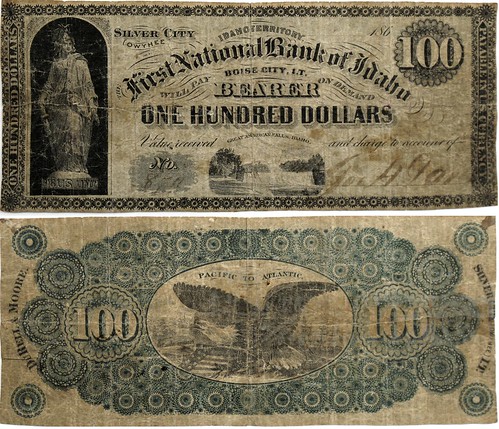
To read the complete lot description, see:
liveauctions.holabirdamericana.com/First-National-Bank-of-Idaho
-Durell-Moore-Note-Territorial-ID-Boise-City_i14654105
Lot 279: Bow Tie Error Cent on Dime
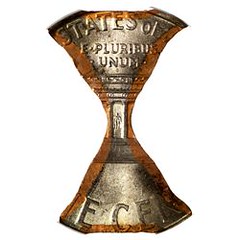 No Date Mint Error 1c Struck on Dime Bow Tie Scrap
No Date Mint Error 1c Struck on Dime Bow Tie Scrap
To read the complete lot description, see:
liveauctions.holabirdamericana.com/No-Date-Mint-Error-1c-Struck-on-Dime
-Bow-Tie-Scrap-_i14654231
To view the complete auction, see:
2012 December Americana & Numismatic Auction
(liveauctions.holabirdamericana.com/2012-December-Americana
-Numismatic-Auction_as25331)
THE BOOK BAZARRE
BALDWIN'S 2013 NEW YORK SALE
2013 will see The New York Sale group celebrate fifteen years of auctions at The New York Coin Convention and these, their 30th and 31st auctions at the event, promise not to disappoint. In keeping with tradition the first day of the two-day event will contain an exciting array of ancient and world coins, including a number of spectacular collections of ancient Greek coins and a fantastic group of over fifty Islamic rarities. Day-two will, as usual, include a plethora of fascinating Russian coins, orders and medals to excite and entice both dealers and collectors alike.
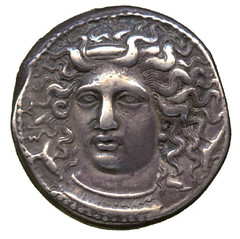 In amongst the numerous gems from the ancient section are some truly stellar pieces, including a beautiful Syracuse, Dionysios I (c. 405-367 B.C.), Silver Tetradrachm from Sicily. This stunning work of art by the master artist Kimon depicts the facing head of Arethusa. She is seen to have an ampyx in her hair upon which is the signature K[IMΩ]N (partially visible.) The signature can also be seen on the exergual line of the reverse of the coin. The head of Arethusa, brought here to the obverse of the coin and set in stunning facing majesty, is both arresting and at the same time serene. Her eyes stare longingly out from the composition, providing the viewer with a genuine sense of the divine and other-worldly. Then, outside of this peaceful gaze, the viewer is overwhelmed by a surprising amount of activity. Her hair flows wildly out behind her and down towards her shoulders and, from this busy arrangement, we can see dolphins emerging into view. These creatures seem almost to be playfully moving to and fro between the locks of her hair.
In amongst the numerous gems from the ancient section are some truly stellar pieces, including a beautiful Syracuse, Dionysios I (c. 405-367 B.C.), Silver Tetradrachm from Sicily. This stunning work of art by the master artist Kimon depicts the facing head of Arethusa. She is seen to have an ampyx in her hair upon which is the signature K[IMΩ]N (partially visible.) The signature can also be seen on the exergual line of the reverse of the coin. The head of Arethusa, brought here to the obverse of the coin and set in stunning facing majesty, is both arresting and at the same time serene. Her eyes stare longingly out from the composition, providing the viewer with a genuine sense of the divine and other-worldly. Then, outside of this peaceful gaze, the viewer is overwhelmed by a surprising amount of activity. Her hair flows wildly out behind her and down towards her shoulders and, from this busy arrangement, we can see dolphins emerging into view. These creatures seem almost to be playfully moving to and fro between the locks of her hair.
The reverse of the coin is full of animation and energy, with a quadriga viewed in three-quarter perspective. The horses are rearing and tossing their heads in the heat of the moment as they speed towards their point of victory. This issue is without doubt one of Kimon’s greatest achievements and the most important of the late fifth century B.C. In addition to this many works of the famous die engravers prevalent in Sicily during the late 5th century B.C. are represented in this collection. All of the coins have prior provenance to Swiss or London auctions and trade. The lot is estimated to sell for US$100,000.
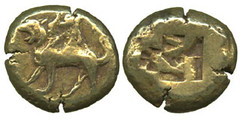 Also included in the ancient section of the sale are two exceptional electrum staters, one of which is believed to be unpublished. The first, a stater from an uncertain Mint in North West Asia Minor (c. 600-560 B.C). The coin is of the greatest rarity, apparently only one of two known examples, the other residing in the British Museum and this being the better preserved of the two. The coin handsomely depicts the mythical beast chimaera, a fire-breathing monstrous creature with the combined parts of a lion, a goat and a
serpent. Although the precise location of the mintage of this fascinating coin is uncertain, it seems that it almost certainly originates from North West Asia Minor. It has been struck on the Phokaian standard, which was prevalent in that region in the early sixth century, encompassing the districts of Teos, Sardes and Kyzikos. Due to the appearance of the chimaera on the obverse, early suggestions were made by scholars that it might have originated from Corinth or Sikyon. However, this is extremely unlikely since the style, fabric, and reverse all point to an Asia Minor attribution. The coin carries an estimate of US$100,000.
Also included in the ancient section of the sale are two exceptional electrum staters, one of which is believed to be unpublished. The first, a stater from an uncertain Mint in North West Asia Minor (c. 600-560 B.C). The coin is of the greatest rarity, apparently only one of two known examples, the other residing in the British Museum and this being the better preserved of the two. The coin handsomely depicts the mythical beast chimaera, a fire-breathing monstrous creature with the combined parts of a lion, a goat and a
serpent. Although the precise location of the mintage of this fascinating coin is uncertain, it seems that it almost certainly originates from North West Asia Minor. It has been struck on the Phokaian standard, which was prevalent in that region in the early sixth century, encompassing the districts of Teos, Sardes and Kyzikos. Due to the appearance of the chimaera on the obverse, early suggestions were made by scholars that it might have originated from Corinth or Sikyon. However, this is extremely unlikely since the style, fabric, and reverse all point to an Asia Minor attribution. The coin carries an estimate of US$100,000.
The second of the two staters an Electrum Stater from the Thraco-Macedonian Region, possibly the Orreskioi, appears to be lacking a direct comparison in the published numismatic literature. The closest parallel is an electrum stater in the British Museum collection, of a similar type, but of a wholly different style and execution. The above coin has been compared with that stater, identified as Orreskioi (?). The obverse of the British Museum’s coin is inferior in terms of both style and execution, displaying a distinct lack of detail when compared with the above coin. The fabric and production of the Museum’s example is also very different, suggesting it is somewhat earlier; the reverse of the above coin displays a much shallower incuse square, which has been neatly divided into four parts corresponding to other Thraco-Macedonian issues of the early fifth century B.C. This excessively rare coin is estimated at US$180,000.
The world coin section, to be held on the first day of the auction, holds yet more excitement with a large offering of Islamic coins. Of the fifty five lots being sold there are two coins that stand out above all others. The first, an al-Walid I, Silver Dirham, al-Daybul 95h (713AD) is an excessively rare piece and is the earliest Islamic coin from the Punjab and the eastern most Umayyad mint. It is estimated to sell for US$15,000. The second is a very fine and extremely rare Silver Dirham, Sijistan 132h (749AD.) The coin is an exceptional item and is an unpublished type, not recorded in any of the standard reference works. The coin is estimated at US$25,000 but it is anticipated that it will achieve more.
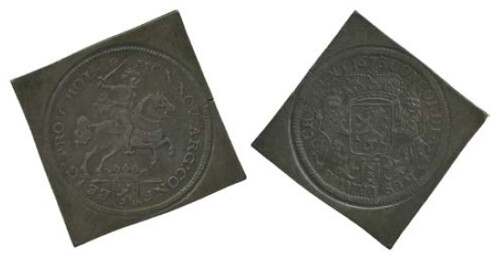
A fantastic 1673 Amsterdam quadruple Taler Klippe (pictured here) is one of the other most notable coins to be included in the world coin section. In early 1672, King Louis XIV of France declared war on the United Provinces, a conflict which lasted for seven years. Arms and ammunition had to be purchased, so the estates of Holland appealed to the rich citizens to hand in their silver so that it could be minted into coins. As there was great urgency, a mint was opened in a disused tower in Amsterdam. 25 workers were hired and the mintmaster from Enkhuysen was asked to supervise the minting. According to Brause-Mansfield, the whole operation was so well organised that within ten months, five million speciethalers were minted. They are considered emergency coins as they were minted from silver supplied by the population.
The Klippe Thalers, of which this unique specimen is the heaviest known, were part of the coin issue of 1673 and were probably presentation pieces. The spectacular example is about uncirculated, unpublished and unique and therefore carries an estimate of US$70,000. Day two will see the usual annual offering of important Russian coins, historical and award medals. There will be around 800 lots in total including a collection of Imperial Russian Orders and Medals and Russian Civil War and Émigré items as well as a major collection of early Soviet Republican Orders, other important USSR Orders and Badges. More details of the items will be available closer to the auction and all the items from the Russian part of the auction will be available that items to view at Baldwin's London office during and after Russian Art week in, November 26 - December 16, 2012.
The catalogues for both auctions will be available from the Baldwin’s website at www.baldwin.co.uk from the first weekend in December.
NUMISMATIK LANZ AUCTION 155, DECEMBER 2012
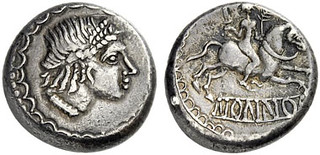
Boii. Nonnos. Hexadrachm, ca. 1st century BC. Göbl XIV/1a
Starting off the auction are 16 coins from the world of the Celts. Of particular note here is a hexadrachm dating back to the 1st century BC that features the inscription NONNOS. Its obverse depicts the head of a nymph that is based on a very special type from the city of Terina (No. 5, Estimate: 10,000 EUR). The prototype itself dates all the way back to the years between 440 and 425 BC. People have pointed to this as earliest evidence of a coin collection – J. Lorenz claims that the Celtic ruler Nonnos had a collection of Greek coins at his princely residence, from which he took the example from Terina to show to a craftsman in order to have the exact same type of coins issued in his name.
 Getas, King of the Edonians (ca. 480-460). Oktadrachm, around 470.
Getas, King of the Edonians (ca. 480-460). Oktadrachm, around 470.
Let’s now take a look at the 346 Greek coins in this auction, among which there are numerous precious pieces just waiting for connoisseurs to discover. Take, for example, a late archaic, extremely fine nomos from Sybaris acquired at the Egger Münzhandlung in Vienna in 1906 for 45 kronen (No. 29; Estimate: 5,000 EUR), or perhaps a tetradrachm from Agrigentum featuring two eagles, gorging on a rabbit (No. 31, Estimate: 6,000 EUR). Incidentally, a dekadrachm of the same type recently became the most expensive ancient coin ever sold in Europe. Also worth noting here is the wonderful tetradrachm from Catane, minted around 450 BC (No. 40, Estimate: 20,000 EUR). It dates back to an auction from Santamaria held in 1961.
The most expensive piece of the entire auction is an extremely fine oktadrachm of Getas, King of the Edonians from 480-460. This coin, which was likely minted in order to render tribute payments to the Persians, features the first use of the term “nomisma.”
To read the complete article, see: Numismatik Lanz, D-Munich (www.coinsweekly.com/en/Preview/6?&id=1186)
Lot 20
GRIECHISCHE MÜNZEN
KALABRIEN
TARENT
AV-Viertelstater, circa 325 - 280. Kamm-Muschel. Rs: Delphin nach rechts schwimmend, darunter Krabbe. Vlasto ('Gold') -; HN Italy -; SNG ANS -; SNG München -; zum Typ vgl. Vlasto 1559. 1,72g. Sehr selten. Sehr schön.
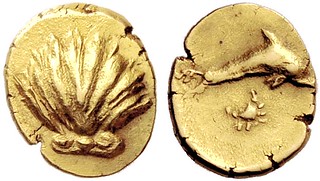
See: www.sixbid.com/browse.html?auction=553&category=12426&lot=573206
Lot 52
GRIECHISCHE MÜNZEN
SIZILIEN
Hieron II. (275 - 215)
Tetradrachme (16 Litrae), im Namen der Königin Philistis, circa 218/17 - 214. Kopf der Königin Philistis mit Diadem und über den Hinterkopf gezogenem Schleier nach links, hinter dem Kopf brennende Fackel. Rs: BAΣIΛIΣΣAΣ / ΦIΛIΣTIΔOΣ. Nike galoppierende Quadriga nach rechts lenkend, vor den Hinterhufen des Gespanns E. A. Burnett, The Enna Hoard and the Silver Coinage of the Syracusan Democracy, SNR 62 (1983), 48; SNG ANS 884; SNG Tübingen 695; CCO 44 (D11/R26). 13,05g. Vorzüglich.
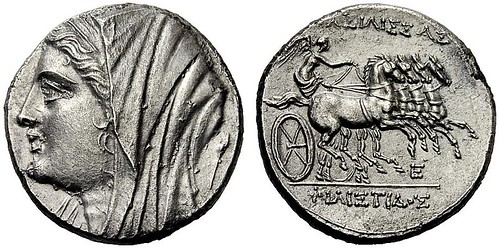
See: www.sixbid.com/browse.html?auction=553&category=12426&lot=573238
Lot 1116
AUSLAND
GROSSBRITANNIEN
George III. (1760-1820)
Guinea 1798. Kopf nach rechts. Rs: Bekröntes Wappen, darunter Jahr. Seaby 3729. 8,40g. Stempelglanz.
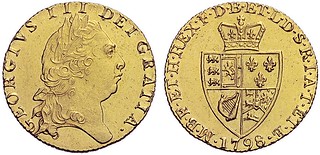
See: www.sixbid.com/browse.html?auction=553&category=12434&lot=574302
To view the auction catalog, see: Numismatik Lanz München | Auction 155 | 10 - 11 December 2012 (www.sixbid.com/browse.html?auction=553)
DRAWER FIND: 1703 QUEEN ANNE VIGO FIVE GUINEA PIECE
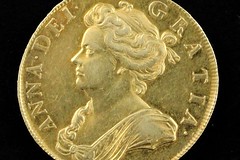 A widow has struck gold after finding a “lost” 18th century coin worth up to £120,000 during a rummage through her late husband’s chest of drawers.
A widow has struck gold after finding a “lost” 18th century coin worth up to £120,000 during a rummage through her late husband’s chest of drawers.
The Queen Anne Vigo five guinea piece was only bought by “seriously wealthy people” back in 1703.
Now the woman will be one herself when it is sold next month.
Auctioneer Leslie Gillham said: “She produced from her bag one or two old silver coins worth a few pounds.
“I flippantly said, ‘It’s a pity you haven’t got any gold ones’ and she said that she had.
“With that she produced this 1703 five guinea coin.
“I thought it must’ve been a fake. I got a second opinion confirming it was genuine and gave her the good news.”
The commemorative coins were made from Spanish gold seized off treasure ships and only 20 were ever struck.
The unnamed pensioner, from Tunbridge Wells, Kent, is selling it at Gorringes on December 6.
To read the complete article, see: You've struck gold! Widow finds old coin in chest of drawers worth £120,000 (www.mirror.co.uk/news/uk-news/queen-anne-vigo-five-guinea-1438995)
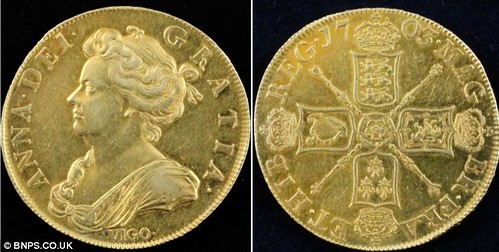
To celebrate the victory over an adversary, the Royal mint had about 20 Queen Anne Vigo five guinea coins made.
Of the 20 that were struck, only 15 are known of and they are in private hands. It is thought the woman’s late husband inherited the exceptionally rare coin as he showed no interest in coin collecting when he was alive.
The series of Vigo coins were made out of 7.5lbs of gold seized from a Spanish galleon. After the British failed to capture Cadiz in October 1702, the fleet intercepted a Spanish treasure ships coming back from America in Vigo Bay.
To read the complete article, see:
Buried treasure! Widow found rare Queen Anne coin minted with stolen Spanish gold worth £120,000 as she cleared late husband's chest of drawers
(www.dailymail.co.uk/news/article-2233806/Buried-treasure-Widow
-discovers-rare-coin-worth-120-000--late-husbands-chest-drawers.html)
EXPERTS DEBATE AUTHENTICITY OF COIN OF EMPEROR PROCULUS
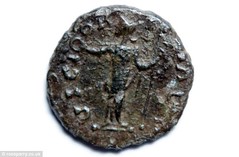 It is the size of a fingernail with battered edges to match.
But this silver coin, discovered in a field, could be worth up to £80,000 if proved to be a genuine Roman antique.
It is the size of a fingernail with battered edges to match.
But this silver coin, discovered in a field, could be worth up to £80,000 if proved to be a genuine Roman antique.
Colin Popplewell, 58, and Mark Hildreth, 38, say the coin - which is the size and weight of a penny - is only the second one in history to be found featuring the short-lived Emperor Proculus.
A metal detecting expert, Julian Evan-Hart, certainly believes the coin is genuine and that it was minted to mark the brief rise to power of Proculus in 280AD.
Father-of-two Mr Popplewell, who made the find in a field near Stamford Bridge, East Yorkshire, on November 7, said: 'The first coin with Proculus was found in a collection in Germany in the 1980s. It sold in 1991 for £40,000.
'It was in a private collection that dated back a century so there was no way of validating whether the coin was authentic or a contemporary forgery, made in the Roman times.
'Our find is ground-breaking because it validates the first coin and gives weight to the history of Proculus - it really will change the history books.'
But coin specialist and renowned academic Roger Bland, who is Keeper of the Prehistory and Europe Department of the British Museum, disagrees that the coin is genuine.'
He said: 'I don't believe any coins of Proculus were ever made and this one is probably a 15th century forgery.
'The only source for our knowledge of him is a controversial history book, written at the end of the 4th century AD, much of which was made up.
'This coin has been made from the same dye, or mould, as another in the Munich Museum, which is widely believed to be fake.
To read the complete article, see:
History-changing coin or a 15C forgery? Debate over ‘Roman’ artefact found in field by metal-detecting friends
(www.dailymail.co.uk/news/article-2233959/Debate-Roman-artefact
-coin-Proculus-field-metal-detecting-friends.html)
SRI LANKAN-JAPAN COMMEMORATIVE COIN AVAILABLE ONLY IN JAPAN
Kavan Ratnatunga of Sri Lanka writes:
My article "Silver coin for 60 Years of diplomacy with Japan" appeared in Sri Lanka Sunday Times on 2012 November 18th.
The color photograph is an unusual touch. But it's another nail in the coffin of good coin design. Is a coin without a design in relief still a coin? -Editor
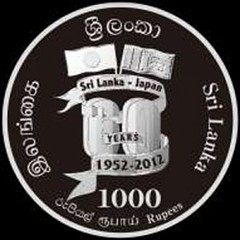
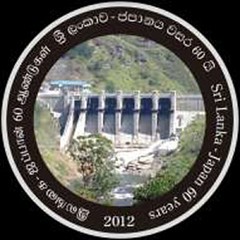
A commemorative one thousand rupee silver frosted proof coin was issued this week to mark 60 years of diplomatic relations between Sri Lanka and Japan.
The frosted proof coin has been struck with twenty grams of sterling silver and has a diameter of 35 mm, which is a new weight and size for Sri Lanka coins. It is the first Lankan coin minted in Japan and first with an actual multi-colour photograph printed on the coin, issued by the local Central Bank (CB).
Both the Central Bank and the Japan Mint have been authorised to retail the coin to interested collectors. The product was over-subscribed and buyers in Japan were selected using a Lottery.
Of the 20,000 coins minted 5,000 were boxed alone and sold in Japan at 6,000 Yen (Rs 10,000). CB ordered a very small number since they don’t expect to sell many at this high price. On 15th November, the CB adding cost of courier charges and VAT, issued about 200 coins to the public at Rs 12,500 each. This is far less than the estimated 1000 coins, needed to meet Numismatic collector demand in Sri Lanka. The remaining 15,000 were packed with a set of 2012 Proof coins of Japan and sold in Japan at 13,000 Yen. This is the first such product with a Lankan coin, but is not sold in Sri Lanka.
To read the complete article, see:
Silver coin for 60 Years of diplomacy with Japan
(www.sundaytimes.lk/121118/business-times/silver-coin
-for-60-years-of-diplomacy-with-japan-20222.html)
Kavan adds:
My primary webpage on this latest NCLT coin with more images is posted at coins.lakdiva.org/commemorative/2012_jplk_dpl60_1000r.html
It is the first coin Minted in Japan for Sri Lanka, and the second foreign order for the state-owned Japanese company which has marketed its expertise in producing coins, as use of coins has fallen in Japan as electronic payment options spread. It has recently managed an order from Bangladesh See www.japantimes.co.jp/text/nb20121114n2.html
MORE COIN-ONLY PARKING METERS DISAPPEAR
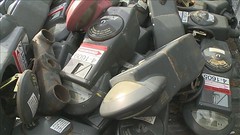 With a few lightning-fast turns of his wrench, 47-year city employee P.J. Peterson ushered in a new age of parking in Minneapolis.
With a few lightning-fast turns of his wrench, 47-year city employee P.J. Peterson ushered in a new age of parking in Minneapolis.
Peterson and an associate removed the last traditional coin-only parking meter still standing in city limits, on Washington Avenue south between 15th Avenue South and Interstate 35W.
It was the last step in a two-year project to update the city's aging single-meter fleet to new, computerized meters that control multiple spaces.
The computer meters are "obviously popular with people who don't want to be chasing around on the floor of their car for coins, and it's good for the city because we don't have to make so many trips to empty the meters out," said City Council member Sandy Colvin Roy.
Colvin-Roy says 55 percent of the 5.7 million people who park on the street in Minneapolis each year now use credit cards to plug their meter.
To read the complete article, see: Last coin-only parking meter pulled from service in Mpls (www.kare11.com/news/article/998480/391/Last-coin-only-parking-meter-in-Mpls-pulled-from-service)
ON SPENDING DIRTY OLD BANKNOTES
 Researchers found we spend old or filthy bank-notes more freely than freshly-minted ones.
Professors Fabrizio Di Muro and Theodore Noseworthy said dirty and clean bank-notes evoke feelings of disgust and pride in equal measure.
Researchers found we spend old or filthy bank-notes more freely than freshly-minted ones.
Professors Fabrizio Di Muro and Theodore Noseworthy said dirty and clean bank-notes evoke feelings of disgust and pride in equal measure.
They said: "The physical appearance of money can alter spending behaviour. Consumers tend to infer that worn bills are used and contaminated, whereas crisp bills give them a sense of pride in owning bills that can be spent around others."
Prof Di Muro, of Winnipeg University, and Prof Noseworthy, of Guelph University in Ontario, said we don't like the idea of touching something countless other people have also handled. This is magnified when a bank-note is dirty, worn or crumpled because we can see evidence this cash has passed through a lot of hands before getting to ours, they said.
The researchers added: "Consumers may value a crisp banknote more than a worn bank-note because they believe the latter is disgusting and thus want to be rid of it." In several studies consumers were given either crisp or worn bills and asked to complete a series of tasks related to shopping.
They tended to spend more with worn bills than with crisp bills. They were also more likely to break a worn larger bill than pay the exact amount in crisp lower denominations. However, when consumers thought they were being socially monitored, they tended to spend crisp bills more than worn bills.
To read the complete article, see:
Filthy banknotes get spent more quickly than crisp notes
(www.telegraph.co.uk/finance/personalfinance/9677664/Filthy-banknotes
-get-spent-more-quickly-than-crisp-notes.html)
THE WORLD'S LARGEST CHINESE CASH COIN
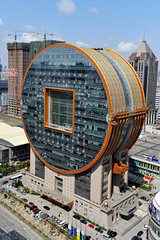 C.Y. Lee, the Taiwanese architect who built Taipei 101, one of the world’s tallest buildings, also made this — one of the world’s ugliest. The 25-floor office block in Shenyang, China, takes inspiration from ancient Chinese coins that were circular with square cutouts in the middle. Abu Dhabi’s Aldar building — also a coin — looks sleek. This just looks clunky.
C.Y. Lee, the Taiwanese architect who built Taipei 101, one of the world’s tallest buildings, also made this — one of the world’s ugliest. The 25-floor office block in Shenyang, China, takes inspiration from ancient Chinese coins that were circular with square cutouts in the middle. Abu Dhabi’s Aldar building — also a coin — looks sleek. This just looks clunky.
To read the complete article, see:
15 Buildings That Don’t Look Like Buildings
(style.time.com/2012/11/05/15-buildings-that-dont-look-like-
buildings/slide/fang-yuan-building/)
THE BIBLIO-MAT OLD BOOK VENDING MACHINE
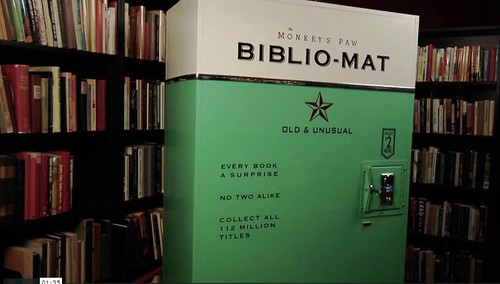
The Biblio-Mat is a random book dispenser built by Craig Small for The Monkey’s Paw, an idiosyncratic antiquarian bookshop in Toronto. Biblio-Mat books, which vary widely in size and subject matter, cost two dollars. The machine was conceived as an artful alternative to the ubiquitous and often ignored discount sidewalk bin. When a customer puts coins into it, the Biblio-Mat dramatically whirrs and vibrates as the machine is set in motion. The ring of an old telephone bell enhances the thrill when the customer’s mystery book is delivered with a satisfying clunk into the receptacle below.
To view the video, see: The BIBLIO-MAT (vimeo.com/53679084)
FEATURED WEB PAGE: THE MYTH OF "VIGO"
This week's Featured Web Page is an article on Harry Mernick's site by Jim Duncan on the coins struck by England from silver and gold taken from a Spanish ship capture in Vigo Bay.There are a number of English silver, and a few gold, coins of 1702-03 which have the word VIGO under Queen Anne's bust. The recent sale of a 5 guinea piece, guinea and half guinea, all three described as extremely rare, provides the perfect excuse to research and report the origins of this privy mark, as far as they can be ascertained!
The coins which carry the "VIGO" privy mark are: 5 Guineas (the Guinea was then 21s6d) dated 1703. Obv: Anne to left, draped, with VIGO beneath the bust. Legend around ANNA • DEI • GRATIA • Rev: crowned cruciform shields, sceptres in angles, rose at centre, legend MAG • BR • ET • HIB REG • 1703 (the date divided by a crown). Edge inscription in relief - • + DECUS • ET • TUTAMEN • REGNI • SECUNDO , c38mm, 41.59g. No mark of denomination. (There are three dies known, but apparently less than 20 surviving pieces, and this is one of only five offered in the last 40 years.) The head of Anne was engraved by John Croker, from a portrait by Sir Godfrey Kneller. (Sold for US$86,000).
Guinea of 1703, sold for US$26,000, and Half Guinea of 1703, sold for US$50,000. All three pieces are similar in design; the Guinea is 8.33 gr, the Half is 4.12g.
Also bearing the VIGO mark are: Crown, Half Crown both dated 1703, and Shilling dated both 1702 and 1703. Unusual in that some of the coin was dated in the year of the seizure.
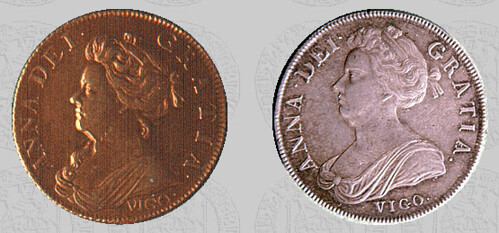
www.mernick.org.uk/lnc/talks/vigo.htm

